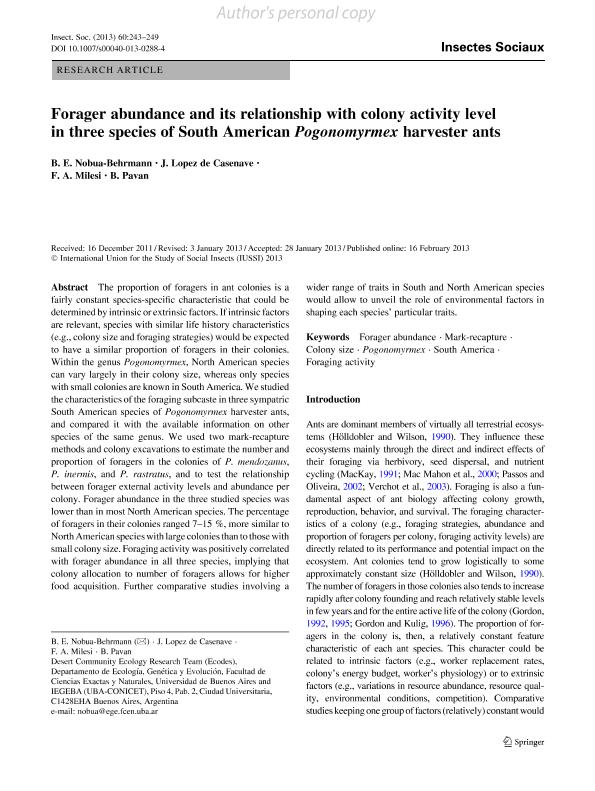Mostrar el registro sencillo del ítem
dc.contributor.author
Nobúa Behrmann, Beatriz Elisa

dc.contributor.author
Lopez de Casenave, Javier Nestor

dc.contributor.author
Milesi, Fernando Adrian

dc.contributor.author
Pavan, B.
dc.date.available
2016-09-06T20:22:03Z
dc.date.issued
2013-02
dc.identifier.citation
Nobúa Behrmann, Beatriz Elisa; Lopez de Casenave, Javier Nestor; Milesi, Fernando Adrian; Pavan, B.; Forager abundance and its relationship with colony activity level in three species of South American Pogonomyrmex harvester ants; Springer; Insectes Sociaux; 60; 2; 2-2013; 243-249
dc.identifier.issn
0020-1812
dc.identifier.uri
http://hdl.handle.net/11336/7500
dc.description.abstract
The proportion of foragers in ant colonies is a fairly constant species-specific characteristic that could be determined by intrinsic or extrinsic factors. If intrinsic factors are relevant, species with similar life history characteristics (e.g., colony size and foraging strategies) would be expected to have a similar proportion of foragers in their colonies. Within the genus Pogonomyrmex, North American species can vary largely in their colony size, whereas only species with small colonies are known in South America. We studied the characteristics of the foraging subcaste in three sympatric South American species of Pogonomyrmex harvester ants, and compared it with the available information on other species of the same genus. We used two mark-recapture<br />methods and colony excavations to estimate the number and proportion of foragers in the colonies of P. mendozanus, P. inermis, and P. rastratus, and to test the relationship between forager external activity levels and abundance per colony. Forager abundance in the three studied species was lower than in most North American species. The percentage of foragers in their colonies ranged 7-15 %, more similar to North American species with large colonies than to those with small colony size. Foraging activity was positively correlated with forager abundance in all three species, implying that colony allocation to number of foragers allows for higher food acquisition. Further comparative studies involving a wider range of traits in South and North American species would allow to unveil the role of environmental factors in shaping each species´ particular traits.
dc.format
application/pdf
dc.language.iso
eng
dc.publisher
Springer

dc.rights
info:eu-repo/semantics/openAccess
dc.rights.uri
https://creativecommons.org/licenses/by-nc-sa/2.5/ar/
dc.subject
Forager Abundance
dc.subject
Colony Size
dc.subject
Pogonomyrmex
dc.subject
Foraging Activity
dc.subject.classification
Ecología

dc.subject.classification
Ciencias Biológicas

dc.subject.classification
CIENCIAS NATURALES Y EXACTAS

dc.title
Forager abundance and its relationship with colony activity level in three species of South American Pogonomyrmex harvester ants
dc.type
info:eu-repo/semantics/article
dc.type
info:ar-repo/semantics/artículo
dc.type
info:eu-repo/semantics/publishedVersion
dc.date.updated
2016-07-22T18:51:58Z
dc.journal.volume
60
dc.journal.number
2
dc.journal.pagination
243-249
dc.journal.pais
Suiza

dc.journal.ciudad
Basel
dc.description.fil
Fil: Nobúa Behrmann, Beatriz Elisa. Consejo Nacional de Investigaciones Científicas y Técnicas. Oficina de Coordinación Administrativa Ciudad Universitaria. Instituto de Ecología, Genética y Evolución de Buenos Aires; Argentina
dc.description.fil
Fil: Lopez de Casenave, Javier Nestor. Consejo Nacional de Investigaciones Científicas y Técnicas. Oficina de Coordinación Administrativa Ciudad Universitaria. Instituto de Ecología, Genética y Evolución de Buenos Aires; Argentina
dc.description.fil
Fil: Milesi, Fernando Adrian. Consejo Nacional de Investigaciones Científicas y Técnicas. Oficina de Coordinación Administrativa Ciudad Universitaria. Instituto de Ecología, Genética y Evolución de Buenos Aires; Argentina
dc.description.fil
Fil: Pavan, B.. Consejo Nacional de Investigaciones Científicas y Técnicas. Oficina de Coordinación Administrativa Ciudad Universitaria. Instituto de Ecología, Genética y Evolución de Buenos Aires; Argentina
dc.journal.title
Insectes Sociaux

dc.relation.alternativeid
info:eu-repo/semantics/altIdentifier/url/http://link.springer.com/article/10.1007/s00040-013-0288-4
dc.relation.alternativeid
info:eu-repo/semantics/altIdentifier/doi/http://dx.doi.org/10.1007/s00040-013-0288-4
Archivos asociados
